Hussam al-Mahmoud | Hassan Ibrahim
Israeli strikes targeting leaders of the Lebanese Hezbollah have changed the nature of the battle on Israel’s northern front and increased the announced losses of the escalation, especially with the death of Hezbollah’s Secretary-General, Hassan Nasrallah, in strikes on Beirut’s southern suburb on September 27.
With Israel hinting at a ground operation preceded by daily raids that killed hundreds of Lebanese and caused mass displacement within Lebanon and to Syria, the Lebanese front adds to an open front in Gaza, raising many questions about the Syrian regime’s stance on developments in the region.
Events in the region took a surprising turn after Israel’s bombing of Hezbollah’s wireless communication devices (pagers), causing heavy casualties, before transitioning to assassinations of senior Hezbollah military leaders, including Nasrallah, Ali Karaki, Mohamed Hussein Sarour, and Ibrahim Aqil, and other leaders of the Radwan Force, who were killed in a strike on Beirut’s southern suburbs on September 20, including Ahmed Mahmoud Wahbi.
As Israeli strikes continue to target Hezbollah leaders, with no regard for American, European, and regional efforts for calm, attention turns to Hezbollah and Iran’s ally, Syrian regime’s president Bashar al-Assad, who has not yet shown serious steps in response to these developments, except for media statements.
Indicators in Lebanon warn of potential conflict expansion, placing the Syrian regime in a “relationship test” with its geographically and politically close ally, and the extent of the Syrian regime’s role or abstention from a war whose humanitarian impacts, at least, transcend Lebanon’s sole land border with an Arab country.
Enab Baladi discusses in this report with experts, researchers, and former politicians the Syrian regime’s dealing with the developments of the battle in southern Lebanon, its position on it, and explores the nature and depth of the relationship with Hezbollah, the Israeli aim from expanding the front and multiple simultaneous battlefields, and the future of the “Axis of Resistance” in light of these developments and Israel’s clear direction towards further escalation.
Words, Not Actions
Where is al-Assad?
The Syrian regime’s handling of events in southern Lebanon has not differed much from its official stance on the events in the Gaza Strip over the past year, following attacks by Al-Qassam Brigades on Israeli settlements surrounding the Strip and the resulting continuous Israeli war that mediation efforts by the US, Qatar, and Egypt have failed to stop to date.
After a sharp escalation in southern Lebanon, beginning with Israel’s bombing of wireless communication devices used by Hezbollah members, followed by daily raids targeting most of the party’s military leadership, causing hundreds of fatalities and thousands of injuries, with mass displacement from southern Lebanon to the interior or towards Syria, the Syrian regime did not deviate from its consistent stance over the past year.
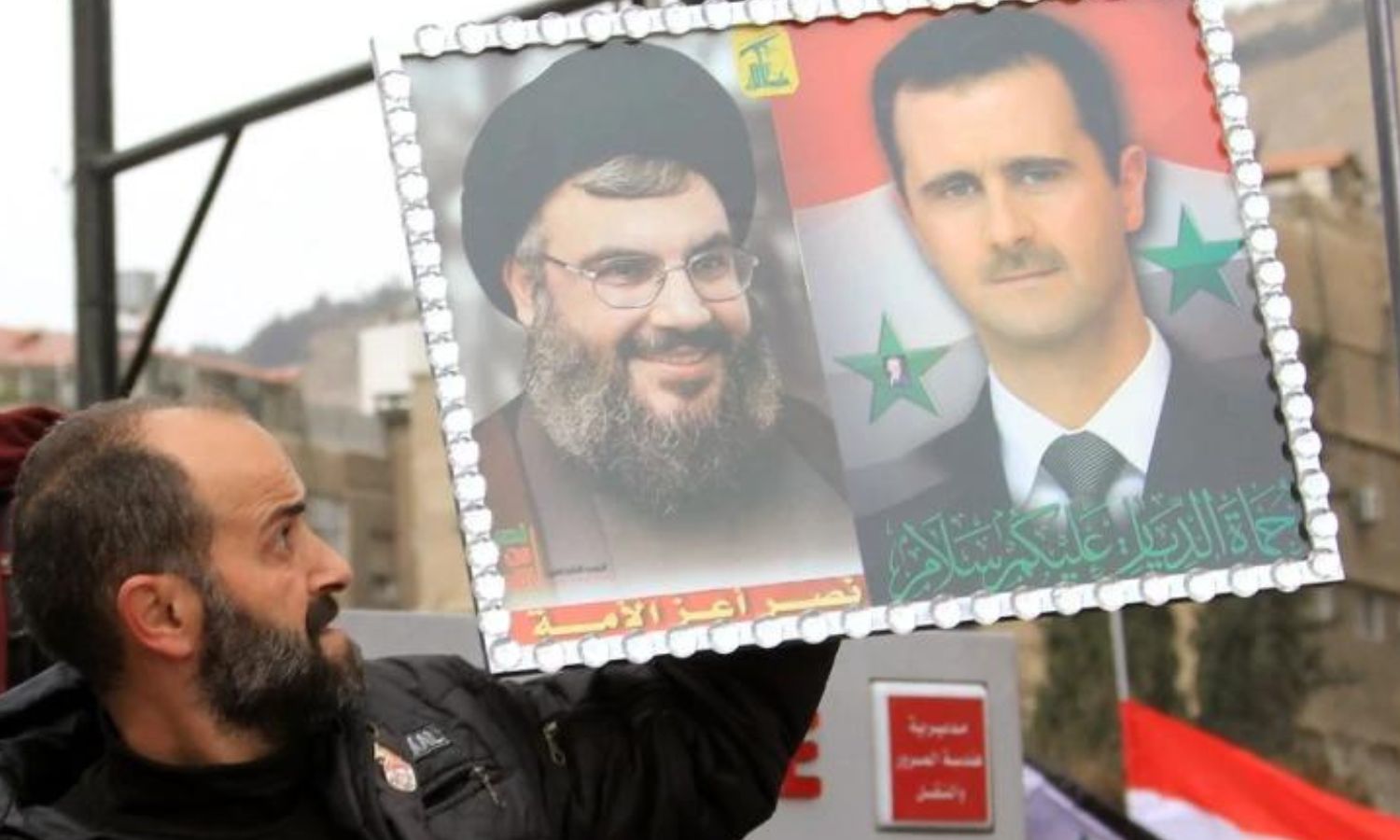
A Syrian man holds a portrait of Bashar al-Assad and Hassan Nasrallah during a pro-Syrian regime rally in Damascus – January 11, 2012 (AFP)
Starting with Syrian regime’s head Bashar al-Assad’s latest appearance during his meeting with members of the new government on September 24, the war file in Lebanon was limited to a reference to the “vicious attack of the Zionists on our brothers in Lebanon,” describing it as “crimes that are difficult to describe or talk about,” urging government members to make their primary goal to stand with the brothers in Lebanon in all areas and sectors without exception or hesitation.
In a speech to the Syrian People’s Assembly on August 25, before Lebanon’s events escalated when operations were limited to light repeated skirmishes under the name “Gaza Support Front,” al-Assad only referred to the liberation of southern Lebanon in 2000 and the “breaking of the West’s arrogance” in Lebanon in 2006, praising the “resisters in Lebanon, Palestine, Iraq, and Yemen” as “icons and models we follow on the path of liberation, dignity, honor, and complete independence.”
After the explosion of Hezbollah’s communication devices on September 17 and 18, disabling 1500 party members with severe injuries like blindness and limb amputation, escalating Israeli strikes increased condemnation statements from the Syrian regime. The Syrian Foreign Ministry condemned Israeli actions, describing them as “terrorist and bloody aggression” and “a bloody crime against civilians in Lebanon,” affirming its solidarity with the Lebanese people’s right to self-defense without clarifying the nature of this support.
In another statement on September 20, the Syrian Ministry of Foreign Affairs declared that the world witnessed a “Zionist aggression” on Lebanon’s southern suburbs, labeling the escalation there as “war crimes and crimes against humanity,” highlighting Israel’s destruction of Gaza and the deaths of approximately 42,000 Palestinians there, and extending greetings to “Syria’s steadfast brothers in Lebanon.”
On September 23, it condemned the “cowardly brutal aggression” on Lebanon, emphasizing that such “criminal acts” should be condemned by all United Nations members.
At the media coverage level, Syrian official and regime-affiliated media expanded their coverage of events in Lebanon, mainly broadcasting news from al-Manar (Hezbollah’s channel), labeling what al-Manar describes as “Islamic resistance” as “Lebanese resistance” without deviating from prior broadcast paths or implementing significant changes, as entertainment, sports, and art news remained present on official Syrian screens promoting the so-called “Axis of Resistance,” deemed a component of the Syrian regime.
Lebanese politician and former deputy head of the Future Movement, Mustafa Alloush, explained to Enab Baladi that the Syrian regime, which did not hesitate to destroy Syrian cities, kill hundreds of thousands, and displace millions to remain in power, found danger in participating even slightly in defense of those who kept it in power (referring to Hezbollah).
According to Alloush, the Syrian regime is not willing to risk itself, thus it limited and will limit itself to reporting news and issuing statements without military or political initiatives, with lacking support since the regime secretly resents Hezbollah, who allowed the Syrian forces’ exit from Lebanon in 2005, benefiting from the Lebanese arena’s exclusivity while potentially showing al-Assad’s inclination to abandon the “resistance project” for other gains.
The Lebanese politician sees Hezbollah disappointed with the “resistance camp,” as is Hamas in Gaza, noting that Nasrallah believed this camp would rush to his aid but found himself alone, hinting that those familiar with the Syrian regime and its nature would not depend on it during tough times.
The Assad regime is incapable of any military initiative, and even if it wished to, the barrel bombs dropped on Syrians are ineffective against Israel. However, al-Assad might benefit from weakening Iran and Hezbollah to escape their control and conduct deals independently.
Mustafa Alloush, Lebanese politician and former deputy head of the Future Movement
Impacts on Syria
Political and geographical circumstances have placed the Syrian regime before another challenge regarding its response to the war directed at Hezbollah, following the starting developments in Gaza. Besides being Lebanon’s neighboring country and only land outlet, Syria is adjacent to the occupied Palestinian territories, making it part of the “Axis of Resistance,” reviving inquiries around the Syrian regime’s official stance toward any conflict involving one of this axis’s members.
On another front, al-Assad faces pressures from two directions, with the first manifesting within the Jordanian Initiative, which explicitly demanded reducing Iran and its military derivatives’ presence in Syria to reach a solution to the Syrian conflict from an Arab perspective. The second direction includes an Israeli warning relayed to Bashar al-Assad by the UAE, advising him to stay out of the Gaza war and prohibiting the use of southern Syria as a launching ground for operations targeting Israel, according to a leak reported by Axios quoting an Emirati official on October 9, 2023, two days after the war in Gaza began.
Jordanian strategic security expert Omar al-Radad explained to Enab Baladi that Hezbollah is well aware of shifts in the Syrian regime’s stance towards it and its relationship with Iran and its role within the “Axis of Resistance,” as Nasrallah implicitly indicated in recent speeches, abstaining from clearly mentioning the Syrian regime multiple times.
According to al-Radad, aside from the known Syrian regime’s stance on Gaza’s events and lack of support for Hamas, while maintaining a diplomatic tone affirming its stand for Palestinian rights, it’s likely this stance similarly applies to Hezbollah.
The Jordanian researcher believes that the Syrian regime’s orientation in these transformations aligns with Russian requests asking Damascus not to intervene in the Gaza war, alongside Arab reconciliations with the Syrian regime in the Jeddah Summit (May 2023).
The new Syrian regime positions represent phases in its profound transformations which could further evolve, especially amidst Iran’s new positions on Hezbollah, according to the Jordanian expert.
On September 24, Iranian President Masoud Pezeshkian stated that “Hezbollah alone cannot stand against a well-armed state with the ability to access weapon systems that far exceed anything else,” referring to Israel, which Tehran used to describe as an entity and raise slogans like “Death to Israel.”
During an interview with American CNN, Pezeshkian added, “What can Hezbollah do alone? Regional and Islamic countries must convene to formulate a reaction before anything more serious occurs.”
Al-Assad and Nasrallah..
Ally or Rival?
The relationship between the Syrian regime with the Lebanese Hezbollah under both Assads, father and son, has been described as a relationship of “brotherhood and loyalty” and deemed “solid and strong,” with Syria considered, according to Hezbollah’s Secretary-General Hassan Nasrallah, the “backbone of the resistance,” while the party acknowledges Syria as “Assad’s Syria,” standing by the regime as a weapon against Syrians following the uprising, causing bloodshed and displacement, preventing its fall (alongside other forces).
The official Syrian decision has supported and aided Hezbollah since its establishment in 1982 with Iranian sponsorship, with Hafez al-Assad showing sympathy to the group, directing the Syrian military leadership and security apparatus to assist it, not envisioning Iran’s scheme in transforming Hezbollah into a military and political base serving its strategic goals, or its ambition in regional expansion, as noted by former Syrian Vice President Abdel Halim Khaddam in his book “The Syrian-Iranian Alliance and the Region.”
After Hafez al-Assad’s death, Hezbollah’s Secretary-General Hassan Nasrallah stated in 2001 that Assad was “always on the firing line, in the resistance arena, in the heart of the conflict,” and that “the corrective movement led by [him] provided a solid base for resistance and steadfastness on truths.”
Hezbollah’s role gradually strengthened in Syria after Bashar al-Assad came to power unopposed in 2000, opening his military arsenals to arm Hezbollah for the first time when the latter engaged in the “July War” (lasting 33 days) in 2006, a step that took Israel by surprise.
Honesty and transparency
With the onset of the Syrian revolution in 2011, Hassan Nasrallah firmly defended Bashar al-Assad and his regime, urging Syrians to preserve it and advising Lebanese not to strike it in the back. He deployed his fighters in prolonged battles in Syria under the pretext of protecting Shia shrines from the so-called “takfiri” groups, later claiming the defense of Syria from collapse.
In May 2013, Nasrallah considered the events in Syria a global war and conspiracy, stating that “Syria is the backbone of the resistance and its support, and the resistance cannot stand idly by while its back is exposed and support is broken, otherwise we would be foolish,” warning that Syria’s fall to American and Israeli hands would lead Israel into Lebanon.
Nasrallah further declared in August of the same year his willingness to personally fight in Syria, saying, “If the battle with these takfiri terrorists requires me and all of Hezbollah to go to Syria, we will go,” and a year later added, “The solution in Syria begins and ends with Bashar al-Assad.”
About four years into the Syrian revolution, in 2015, Bashar al-Assad legitimized Hezbollah’s fighting alongside his forces, asserting that his personal relationship with Nasrallah was a “close bond more than 20 years old” characterized by honesty and transparency, and that Nasrallah is “faithful to the utmost limits of loyalty.”
Killing ground and weapons transit
In recent years, Hezbollah has served as a military auxiliary to al-Assad’s forces in battles in Aleppo, Latakia, Daraa, rural Damascus, Aleppo, Homs, and rural Hama. Its siege and bombardment of Zabadani and Moadamiya resulted in over 300 civilian deaths, 84 of whom died of acute starvation. Its members committed dozens of massacres in Syria, one of which was in al-Qusayr, rural Homs, leading to the deaths of 273 people and injuring over 2400.
By mid-this year, Hezbollah‘s military sites in Syria had reached 241 locations, including joint sites with the Iranian Revolutionary Guard Corps (IRGC).
Syrian land forms part of an Iranian corridor leading to Syria and Lebanon by land, air, and sea, run clandestinely by Tehran at varying rates, involving weapons smuggling to Syria and Lebanon and infrastructure for producing and assembling advanced conventional weapons on Syrian soil, such as the precision missiles project in Masyaf, as reported by the Israeli Alma Research Center in October 2022.
In June, seven regional officials, diplomats, and Syrian officers reported that Israel had intensified its secret strikes in Syria against weapons sites, supply routes, and Iranian-linked leaders to ensure Hezbollah’s weakening in Syria.
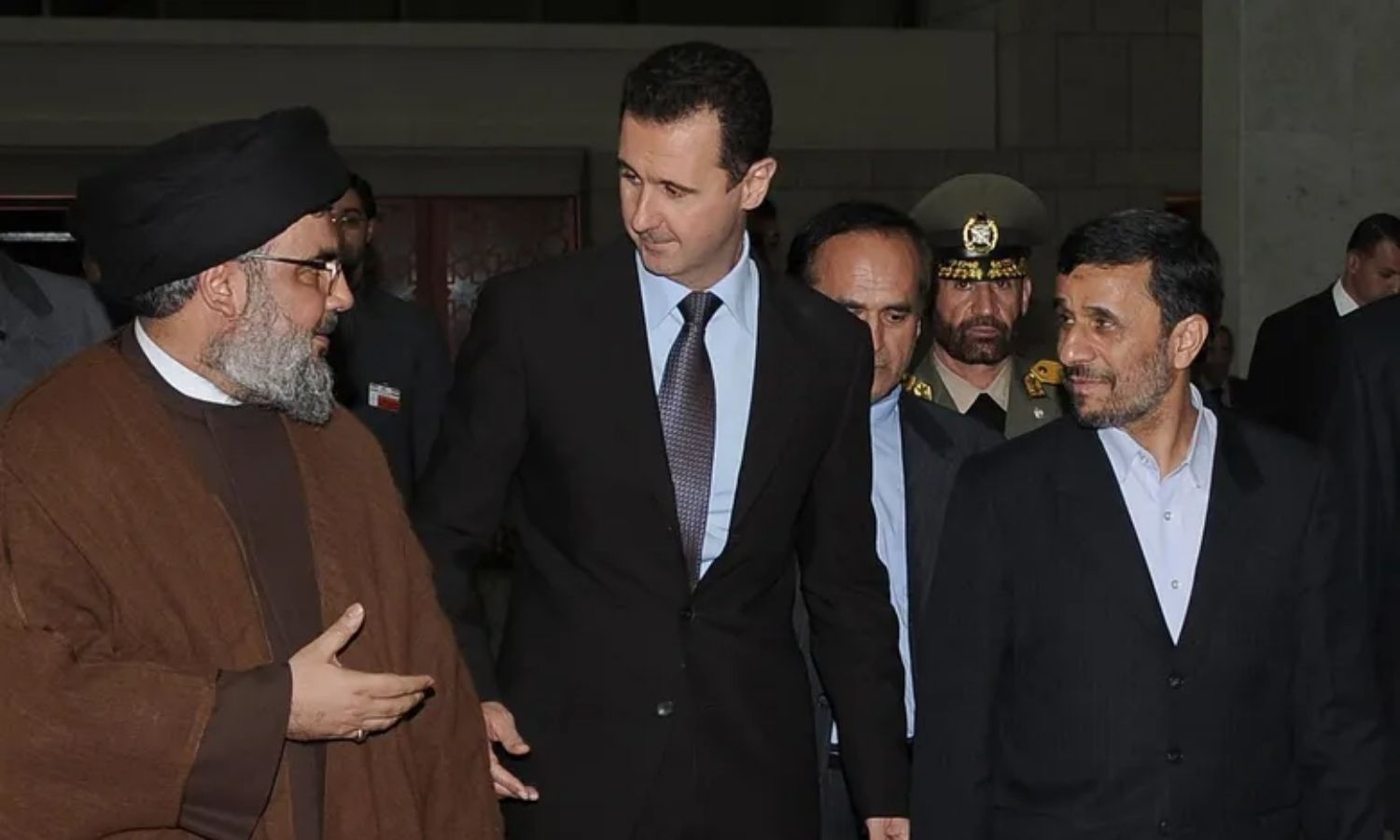
The Syrian regime’s president Bashar al-Assad (center), Hezbollah’s leader Hassan Nasrallah (left), and the former Iranian president Mahmoud Ahmadinejad (right) in the Syrian capital Damascus (SANA)
“No change in relationship”
This “strong” and historically-rooted relationship with Hezbollah has sparked questions about the current nature of the relationship amid escalating tensions and signs of a possible upcoming war. Researchers are curious about the impact of these developments and whether the relationship could take a divergent course, along with the implications of such changes if they occur.
Sam Heller, a researcher at Century Foundation for International Research and Policy, clarified to Enab Baladi that Hezbollah and Damascus remain allies and are likely to remain so, dismissing the likelihood of significant change in the relationship, which suggests the changes in the regime’s membership and participation in the wider “Axis of Resistance.”
Heller does not expect Damascus to make additional efforts to support Hezbollah beyond what it currently does, suggesting that the most crucial contribution of the government’s current fight with Hezbollah may have occurred before the war, through how the regime assisted Hezbollah in developing its capabilities and physical infrastructure in Lebanon and Syria.
Realistically, Syria can no longer add much once the war started, but so far, Syria represents Hezbollah’s strategic depth and remains a significant potential supply line if the conflict extends.
Sam Heller, a researcher at Century Foundation for International Research and Policy
A complex, non-bilateral relationship
During its military intervention in Syria, Hezbollah’s role was less focused on rebuilding and enhancing regime forces’ capabilities, with more emphasis on creating parallel formations like pro-regime militias. This mirrors Hezbollah’s behavior in Lebanon, where it built an independent armed force detached from the frail Lebanese state, according to a study by the Malcolm Kerr-Carnegie Middle East Center.
According to the study, the alliance between Hezbollah and Syria has reached a new stage where Hezbollah does not merely impose the terms of the relationship but also has room to expand its ideological, military, and political influence inside Syria.
The Syrian political researcher Nader al-Khalil believes that it is essential to consider and understand the complexities of the Syrian scene when talking about the nature of the relationship between the regime and Hezbollah, as considering them wholly independent allies making decisions with their full independent will is inaccurate.
Al-Khalil told Enab Baladi that the regime does not have complete independence in its decisions concerning Hezbollah, as there are Iranian infiltrations within the regime’s structure, and Hezbollah has gained influence too, making Syrian decisions regarding this relationship not entirely independent.
He added that the direct field influence of Hezbollah and through its Iranian allies established an allied relationship with power centers within the regime’s structure, whether by the willing involvement of the regime’s head, Bashar al-Assad, or involuntarily.
One can compare the Syrian regime to a “joint-stock company” where multiple parties share influence; al-Assad holds shares, as do the Iranians, Hezbollah, and Russians. According to al-Khalil, this complexity makes the relationship between the regime and Hezbollah a “non-bilateral” and not simple alliance but part of a broader network of interests and alliances.
Researcher al-Khalil believes that the relationship faces several challenges amid ongoing escalation. Al-Assad does not have the capability to decide to independently engage in war with Israel in support of Hezbollah, and it is unlikely that he would engage in such a war purely for Hezbollah’s sake.
Syria might be used as a support base for the party against the regime’s will if the war turns into an existential threat to Hezbollah, as seen with Hamas in Gaza. Tensions and changes might occur within the Syrian regime, especially between the ruling family and top figures within security and military apparatuses, concerning relations with the party and Iran.
The relationship between the Syrian regime and Hezbollah is highly complex and intertwined with regional and international balances, making it difficult to predict its development amid current challenges. The magnitude of the Israeli threat to Hezbollah, its nature, and possible outcomes remain too early to precisely analyze.
Nader al-Khalil, Syrian political researcher
Can Israel break the “Axis of Resistance”?
Israel capitalized on the October 7 attack, directing its fury at the “Axis of Resistance,” or at least several of its components. Its strikes hit the Iranian embassy in Damascus at the start of April, assassinated influential Axis commanders inside and outside Iran, including the commander of the Quds Forces in Syria and Lebanon, Mohammad Reza Zahedi, during an embassy targeting in Damascus, and the head of the political bureau of the Islamic Resistance Movement (Hamas), Ismail Haniyeh, assassinated on July 30 while in Iran, hours after meeting the supreme leader, Ali Khamenei.
Meanwhile, Hezbollah’s quick involvement in the “Gaza Support Front” met with fierce Israeli escalation over the past days, when senior military leaders in the party were assassinated through a slow sequence since the start of the war, or with escalated waves of assassinations in recent weeks.
Simultaneously, Israeli strikes on military sites in regime-controlled areas in Syria have not ceased. The latest was an Israeli air attack from the direction of occupied Syrian Golan targeting military sites on the Syria-Lebanon border near Kfier Yabous in rural Damascus, killing five soldiers and wounding another on September 27.
This Israeli bombardment follows similar shelling that targeted the Matriba crossing on the Syria-Lebanon border, with the Israeli army stating on September 26 that it struck infrastructure on the Syria-Lebanon border used by Hezbollah for smuggling weapons from Syria to Lebanon, clarifying its aim to prevent the entry of weapons to Lebanon for arming Hezbollah while continuing to attack the party’s military capabilities and infrastructure.
All these factors raised questions about Israel’s goals in escalating on multiple fronts simultaneously. The official Israeli rhetoric against any truce before “eliminating Hamas” and “securing the Israeli home front,” ensuring no repeat of October 7, remains unabated.
A near ground war
The political researcher and Director of Research at the Omran Center for Strategic Studies, Maan Talaa, sees that Israel seeks to widen the rules of engagement, change them, and advance them to higher levels, being close to slipping into a ground war or land incursion.
Talaa explained to Enab Baladi that Israel has purposes and goals from its escalation in Lebanon, aiming to eliminate any potential pressure from outside Gaza and prevent any disruption to the sector, especially given its apprehension towards the policies of the “Axis of Resistance.” Additionally, it seeks to improve the perception of the Israeli army internally, whose image remains faltering in Gaza without achieving its declared objectives.
There is also an attempt to establish a personal legacy for Israeli Prime Minister Benjamin Netanyahu, registered as having responded to the Al-Aqsa Flood operation with a severe reaction, contributing to delaying the accountability files managed against him internally.
Among these factors is testing the so-called “strategy of changing the security rules governing the equations of engagement with Israel,” seeking to retain the form of the “Axis” while changing its substance by depriving it of qualitative power tools. This includes obstructing or challenging the path of undisclosed negotiations between Tehran and Washington, which are disengaged in the region, as Washington is not eager to return to the Middle East, particularly amidst current American election challenges.
Israel’s goal is to remove elements pressuring its national security—militarily, humanly, and administratively—from conflict equations through a Gaza war or by destroying adversaries’ powers, not by breaking the axis, but by maintaining its current form to secure functional and structural failures within this axis.
Maan Talaa, Political researcher
According to Talaa, the data speak of a severe blow to Iran’s elements, with repercussions becoming visible now through the clear change in political tug-of-war equations in Lebanon, narrowing the Syrian regime’s options further towards limitation and its resistance to its allies in preventing Syrian geography from becoming a war platform. Additionally, this involves weakening Iran and causing a disruption in the regional security system, which some countries and parties will either fill or adapt to its absence.
Talaa also noted Iran’s desire to use its regional tools and improve negotiation conditions to reinforce its positioning in the regional security system without giving any indication of sliding into a major war, even if the rules of engagement are altered. Iran aims to maneuver these tools and utilize its power conditions in negotiations, alongside the desire to preserve its gains in the region and its long-term investments that cost financially, securely, or politically, thus ending the state of concern over its interests in the region, clearly manifested in Gaza and Lebanon, and the fragile Arab normalization and potential Turkish normalization with the regime.
The regime’s reluctance to intervene
For the Syrian regime, the options are limited and narrow, focusing on internal retreat and trying to separate the Syrian file from regional issues, exploiting political openness towards it, with aspirations of turning it into economic openness, while widening margins with “allies” or even aligning with normalization demands without being dragged into any significant step that reflects negatively on its control over the Syrian scene, according to Maan Talaa.
if you think the article contain wrong information or you have additional details Send Correction
النسخة العربية من المقال
-
Follow us :
Most viewed
- Intentions for popular resistance amid Israeli escalation in southern Syria
- Al-Sharaa names new Syrian government
- Kurdish Protection Units: Key point of contention between Damascus and SDF
- Syrians look forward to visiting graves of "martyrs" on Eid morning
- Syrian returnees celebrate first Eid after liberation












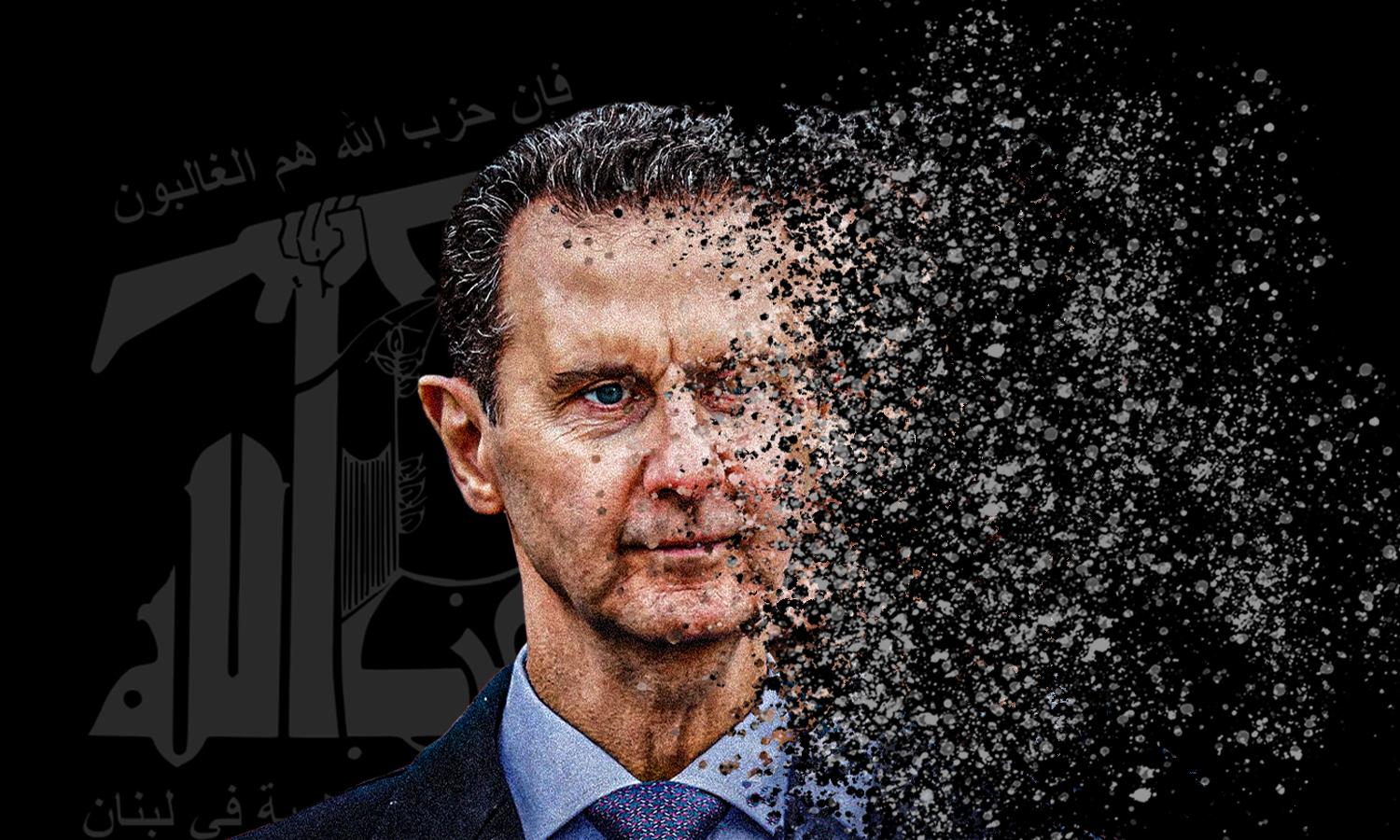
 The Syrian regime has not taken any practical steps to support its ally Hezbollah against Israel, limiting its response to statements of condemnation (Enab Baladi)
The Syrian regime has not taken any practical steps to support its ally Hezbollah against Israel, limiting its response to statements of condemnation (Enab Baladi)





 A
A
A
A
A
A
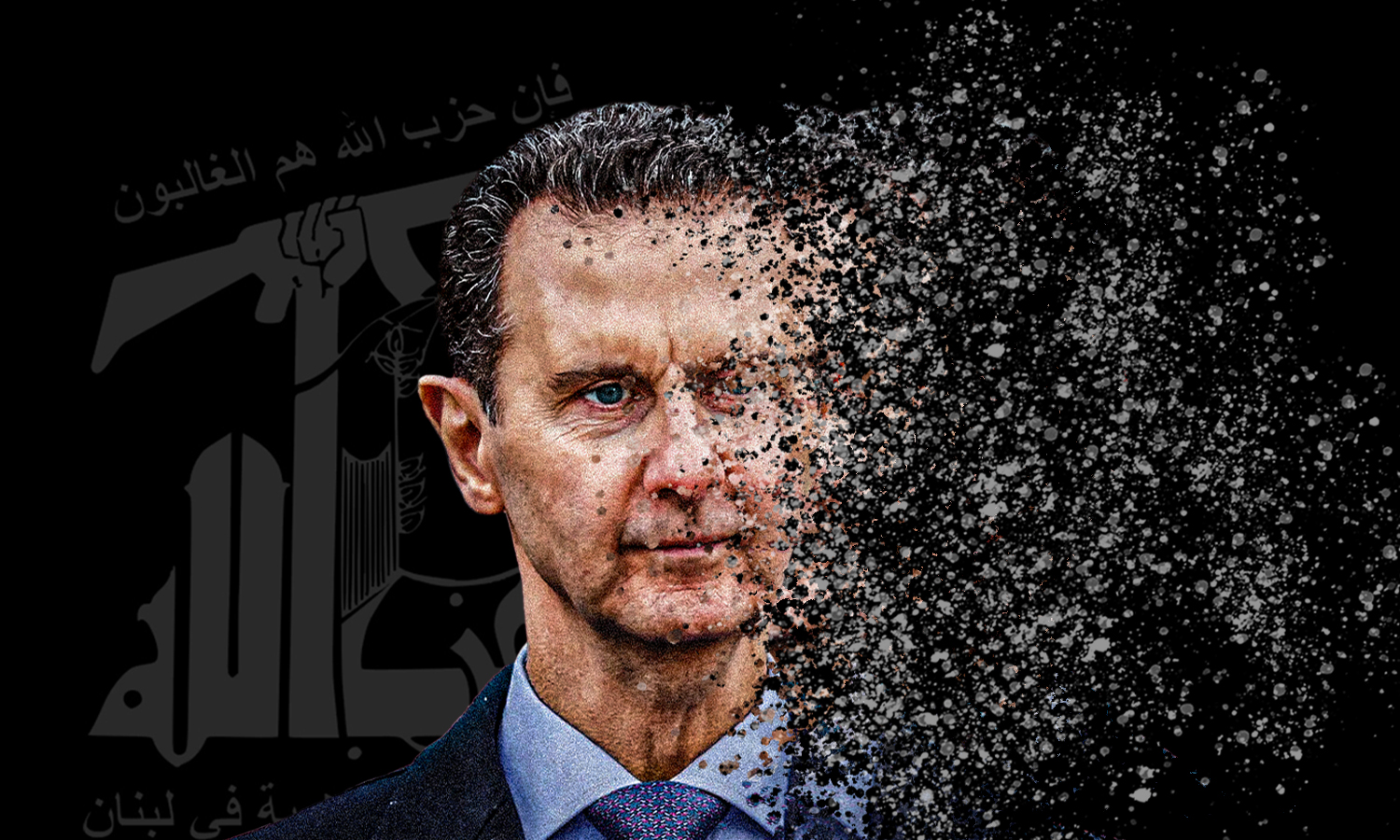
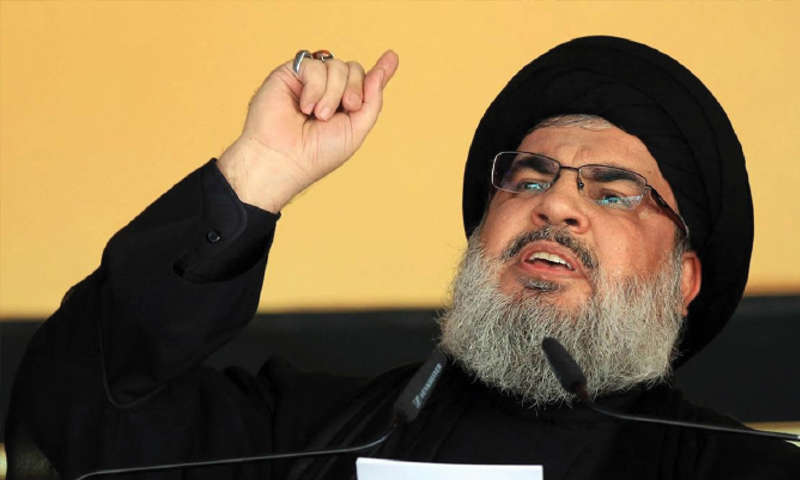





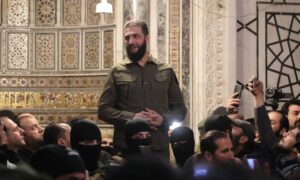
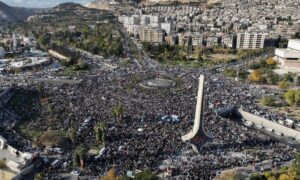
 More In-Depth
More In-Depth